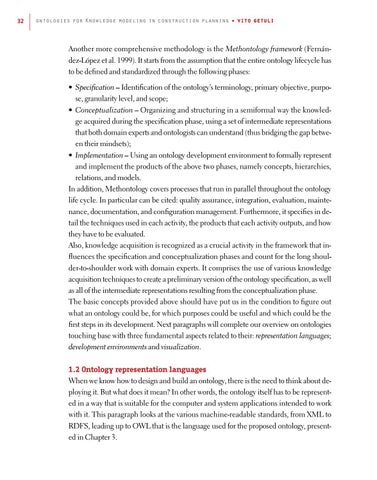32
ontologies for Knowledge modeling in construction planning • vito getuli
Another more comprehensive methodology is the Methontology framework (Fernández-López et al. 1999). It starts from the assumption that the entire ontology lifecycle has to be defined and standardized through the following phases: • Specification – Identification of the ontology’s terminology, primary objective, purpose, granularity level, and scope; • Conceptualization – Organizing and structuring in a semiformal way the knowledge acquired during the specification phase, using a set of intermediate representations that both domain experts and ontologists can understand (thus bridging the gap between their mindsets); • Implementation – Using an ontology development environment to formally represent and implement the products of the above two phases, namely concepts, hierarchies, relations, and models. In addition, Methontology covers processes that run in parallel throughout the ontology life cycle. In particular can be cited: quality assurance, integration, evaluation, maintenance, documentation, and configuration management. Furthermore, it specifies in detail the techniques used in each activity, the products that each activity outputs, and how they have to be evaluated. Also, knowledge acquisition is recognized as a crucial activity in the framework that influences the specification and conceptualization phases and count for the long shoulder-to-shoulder work with domain experts. It comprises the use of various knowledge acquisition techniques to create a preliminary version of the ontology specification, as well as all of the intermediate representations resulting from the conceptualization phase. The basic concepts provided above should have put us in the condition to figure out what an ontology could be, for which purposes could be useful and which could be the first steps in its development. Next paragraphs will complete our overview on ontologies touching base with three fundamental aspects related to their: representation languages; development environments and visualization. 1.2 Ontology representation languages When we know how to design and build an ontology, there is the need to think about deploying it. But what does it mean? In other words, the ontology itself has to be represented in a way that is suitable for the computer and system applications intended to work with it. This paragraph looks at the various machine-readable standards, from XML to RDFS, leading up to OWL that is the language used for the proposed ontology, presented in Chapter 3.








